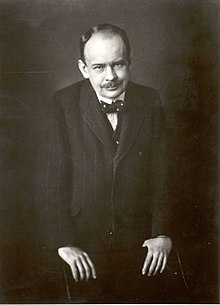Max Dvořák
| Max Dvorak | |
|---|---|

Max Dvořák. Photo by Anton Kolm.
|
|
| Born |
4 June 1874 Roudnice nad Labem, Bohemia |
| Died |
8 February 1921 (aged 46) Hrušovany nad Jevišovkou, Czechoslovakia |
| Occupation | Austrian art historian |
Max Dvořák (4 June 1874, Roudnice nad Labem, Bohemia – 8 February 1921, Hrušovany nad Jevišovkou, Czechoslovakia) was a Czech-born Austrian art historian. He was a professor of art history at the University of Vienna and a famous member of the Vienna School of Art History, employing a "Geistesgeschichte" methodology.
Dvořák was the son of a Bohemian archivist and librarian. He studied at the universities of Prague and Vienna. In 1897, he completed a PhD thesis in history at the Institut für Österreichische Geschichtsforschung, Vienna. Being impressed by the teaching of art historian Franz Wickhoff, he focused his attention to art history and wrote his Habilitationsschrift on Bohemian thirteenth- and fourteenth-century manuscript illumination by Johannes von Neumarkt (1901). In 1902 he was appointed lecturer in art history at the University of Vienna. After Alois Riegl's death in 1905, he became, with the help of Julius von Schlosser, curator of public monuments in Austria. In 1909, he was appointed full professor of art history at the University of Vienna, which caused some problems among the nationalists of the art faculty because of Dvořák's Czech origin. Therefore, Josef Strzygowski set up his own, competing art history institute, known as the "Wiener Institut", within the same university, resulting in Dvořák and Strzygowski teaching from two different art history "centers".
Dvořák was one of the main representatives of the Vienna School of Art History, his most important publication being on the concept of art history as a history of ideas (Kunstgeschichte als Geistesgeschichte). In 1905, he succeeded Riegl as general curator of the Imperial Central Commission for the study and conservation of art and historical monuments, today Bundesdenkmalamt. He helped save many Austrian art treasures for post-World War I war reparation. He also continued the publication of the Kunstgeschichtliches Jahrbuch der Zentralkommission für die Erhaltung der Kunst- und historischen Denkmale, and in 1907, he established an inventory of Austrian and Hungarian monuments, called Österreichische Kunsttopographie. Also in 1907, he created the first complete catalogue of The Lobkowicz Collections. In 1916 he published his standard work, Katechismus der Denkmalpflege, in which he was able to raise a broad understanding for the concerns of monument protection.
...
Wikipedia
